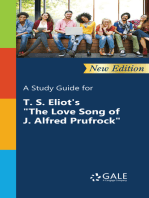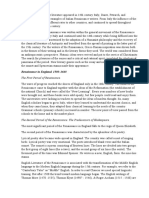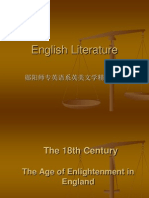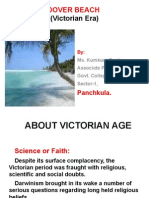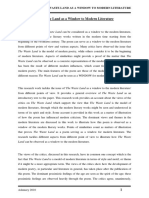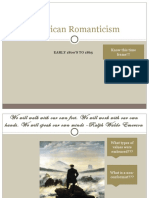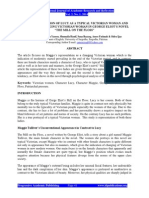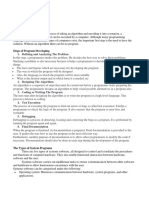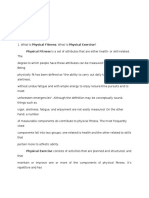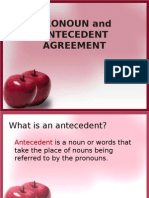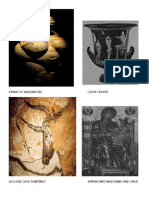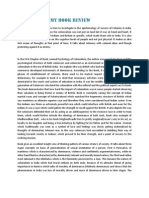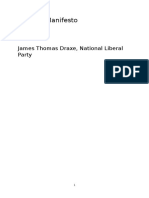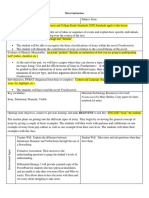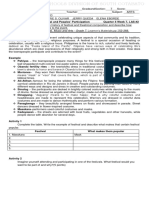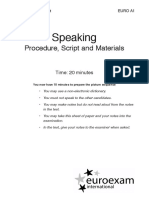Victorian Period: Progress and Decline
Victorian Period: Progress and Decline
Uploaded by
JC ChavezCopyright:
Available Formats
Victorian Period: Progress and Decline
Victorian Period: Progress and Decline
Uploaded by
JC ChavezOriginal Description:
Original Title
Copyright
Available Formats
Share this document
Did you find this document useful?
Is this content inappropriate?
Copyright:
Available Formats
Victorian Period: Progress and Decline
Victorian Period: Progress and Decline
Uploaded by
JC ChavezCopyright:
Available Formats
1833 Slavery abolished in British
empire.
1837 Victoria becomes queen.
1839 Michael Faraday offers general
theory of electricity.
1843 William Wordsworth becomes a
poet laureate.
1850 Elizabeth Barrett Browning
publishes Sonnets from the
Portuguese
1859 Charles Darwin publishes On
the Origin of Species
1860 Florence Nightingale founds
school for nurses.
1865 London Fire Department
established.
1865 Lewis Carroll publishes
Alices Adventures in
Wonderland
1868 Robert Browning publishes
The Ring and the Book
1880 Joseph Swan installs first
electric lighting.
1884 First book (A-ant) of Oxford
English Dictionary published
1887 First Sherlock Holmes tale
published.
1891 Thomas Hardy publishes Tess
of the dUrbervilles
1896 A.E. Housman publishes A
Shropshire Lad
1901 Queen Victoria dies.
During the sixty-four years of Queen
Victorias reign, from 1837 to 1901,
Britains booming economy and rapid
expansion encouraged great optimism.
Britain became the world leader in
manufacturing.
Economic and military power,
especially naval power, helped Britain
acquire new colonies in far-flung
parts of the globe.
All was not really right with the
world of industrial England.
Writers exposed brutal factory
conditions and stinking slums, the
dark underside of a manufacturing
economy.
Annoyed by the reformers and radicals
of many sorts, Victorian leaders did
take steps to expand democracy and
better the lot of the poor.
Two key issues trade policy and
electoral reform dominated domestic
politics during the first half of the
Victorian Era.
The trade controversy centered on the
Corn Laws, which had long placed high
tax on corn (grain).
These laws discouraged food imports
and helped British landlords and
farmers keep food prices high, which
angered the poorer classes.
Reform came in 1846 when
Parliament, confronting a massive
famine in Ireland (1845 1849),
sought to increase the food supply by
suspending the Corn Laws.
Over the following decade, the free
trade policy was established.
The other burning issue during the age
involved strengthening democracy.
In 1838, the London radical William
Lovett drew up a Peoples Charter
demanding universal suffrage for all
males, not just wealthy and middle
classes.
Renewed demands for electoral change
led to the Second Reform Bill of 1867,
which added 938,000 people to the
number of voters by granting voting
rights urban workingmen.
Two further Acts, the Third Reform
Act (1884-1885) and the
Redistribution Act (1885), advanced
the country toward universal male
suffrage.
Women were then allowed to attend
universities.
Parliament passed laws to reduce
working hours for women and children,
to establish a system of free grammar
schools and to legalize trade unions.
Though the Liberals (formerly the
Whigs) advocated limits to British
rule, the Empire continued to grow.
Britain acquired Hong Kong from China
in 1842.
Then, after a rebellion in 1857 to 1858
by sepoys (Indian troops under British
command), Britain shouldered aside the
British East India Company and took
direct control of India.
In the last three decades of Victorias
rule, Britain expanded its influence in
Africa.
Victorian thinkers often disagreed on
the crucial issues of their times, but
they shared a deep confidence in
humanitys ability to better itself.
The Victorians fought with the
religious and philosophical as well as
the social implications of modern life.
The theory of evolution proposed by
Charles Darwin (1809-1882) in On
the Origin of Species by Means of
Natural Selection (1859), stirred
bitter controversy.
Some Victorian thinkers took Darwins
theory as a direct challenge to biblical
truth and traditional religious faith.
Others accepted both Darwin and
religion, striving to reconcile scientific
and religious insights.
Literature of the Period
Romanticism continued to influence
Victorian writers, but it had by now
become part of the mainstream culture.
When Victorian writers confronted the
rapid technological and social changes, a
literary movement known as Realism was
born.
The literature of this movement
focused on ordinary people facing day-
to-day problems of life, an emphasis
that reflected the trend toward
democracy and growing middle-class
audience for literature.
Literature of the Period
A related movement, known as
Naturalism, sought to put the spirit of
scientific observation to literary use.
Naturalists crammed their novels with
gritty details the sour smell of
poverty, the harsh sounds of factory life
often with the aim of promoting social
reform.
They directly contradicted the
Romantic idea that nature mirrored
human feelings and instead portrayed
nature as harsh and unsympathetic to
the human suffering it caused.
Literature of the Period
Rather than embracing real life as
the advocates of Realism did, the
poets and painters of the Pre-
Raphaelite Brotherhood, formed in
1848, rejected the ugliness of
industrial life.
They turned for inspiration to the
spiritual intensity of medieval Italian
art, the art before the time of the
painter Raphael (1483-1520).
The Victorian Age produced a large
and diverse body of poetry. The
Romantic style predominated at first,
but Realism and Naturalism gained
force as time went on.
VICTORIAN POETRY
The most popular poet of the era and
was influenced by earlier Romantic
poets.
His verse displays a keen sense of the
music of language and some of his
more sentimental lyrics even
reappeared in popular songs.
Tennyson also revealed a deeper, more
thoughtful side in such powerful poem
as Ulysses and In Memoriam
(1850).
He became poet laureate after
Wordsworth died in 1850.
VICTORIAN POETRY
He produced a body of poetry as diverse
as Tennysons, although in his lifetime he
never achieved equal public acclaim.
His works showed the influence of
Realism as he sought to portray
individuals without Romantic
authenticity.
Critics have admired his dramatic
monologues , or long speeches in which
a character reveals his or her
thoughts.
ELIZABETH BARETT
BROWNING
(1806-1861)
VICTORIAN POETRY
The wife of Robert Browning and was
more famous poet at the time of
their marriage.
Today, she is remembered mostly for
the beautiful loves poems she wrote
for her husband in Sonnets from the
Portuguese (1850)
VICTORIAN POETRY
One of the greatest Victorian poets who
focused on the bewildering confusion of
the Industrial Age.
He was troubled by the individuals close
ties to nature and with each other.
A forerunner of the more pessimistic
Naturalist poets, such as Hardy and
Housman.
and
VICTORIAN POETRY
Both were pessimistic Naturalist
poets.
For them, lifes disappointments were
a frequent subject.
VICTORIAN POETRY
His poetry spoke to the expansive spirit
of the age, ranging across the wideness of
the Empire.
He wrote action-packed narrative poems
like Gunga Din and poem written in
the colourful speech of working-class
soldiers in Barrack-Room Ballads.
GERARD MANLEY HOPKINS
(1844-1889)
While Tennysons and Kiplings well-
known lyrics turned up as popular
songs, Hopkins remained unpublished
during his own century.
His innovative rhythms and deeply felt
religious verse would inspire the
twentieth-century Modernist poets.
Members of the new middle class
were avid readers and they loved
novels, especially those novels that
reflected the major social issues during
the age.
THE BRONTE SISTERS:
Emily Bronte (1818-1848),
Charlotte Bronte (1816-1855)
and the lesser-known Anne Bronte
(1820-1849)
Romanticism heavily influenced these
early Victorian novelists.
The sister were among the six children
raised by their father and aunt in the
isolation of the northern English
village.
They were bright and imaginative and
read great authors like Shakespeare
and Byron.
Emily and Charlotte later created
powerful works of fiction.
Emilys classic Wuthering Heights
(1847) tells the tale of the doomed
passion of Catherine Earnshaw to
Heathcliff.
Charlotte wrote Jane Eyre (1847),
a novel recounting the adventures of a
governess who falls in love with her
mysterious employer, Mr. Rochester.
Regarded by many critics as the
greatest novelist of the period.
Dickens filled his novels with poignant,
realistic details that dramatized the
contrast between rich and poor in
industrial England.
His novels abound in deliciously
eccentric characters whose every
peculiarity of speech and gesture
affirms how individual people are.
Among his greatest works are David
Copperfield (1849-1850), Bleak
House (1852-1853) and Our Mutual
Friend (1864-1865)
You might also like
- English Romantic PoetryDocument63 pagesEnglish Romantic PoetryCemil Altınbaşak100% (4)
- British Literature TimelineDocument10 pagesBritish Literature TimelineMegan Vivia van WykNo ratings yet
- The Rise of The NovelDocument2 pagesThe Rise of The NovelcarlaNo ratings yet
- A Study Guide (New Edition) for T. S. Eliot's "The Love Song of J. Alfred Prufrock"From EverandA Study Guide (New Edition) for T. S. Eliot's "The Love Song of J. Alfred Prufrock"No ratings yet
- GANGSADocument7 pagesGANGSACLAIRE BALTAZAR0% (1)
- Ardenne High School 6 Form Application FormDocument13 pagesArdenne High School 6 Form Application FormPatrice Campbell0% (1)
- TW VictorianPoetry BrowningDocument12 pagesTW VictorianPoetry BrowningTaibur RahamanNo ratings yet
- A Survey of American LiteratureDocument7 pagesA Survey of American LiteratureAnamariaSabau100% (1)
- Lady of The Shallot NotesDocument4 pagesLady of The Shallot NotesSarah KabbaniNo ratings yet
- English LiteratureDocument22 pagesEnglish LiteratureVidhi Chokhani67% (3)
- Victorian Literature Research PaperDocument24 pagesVictorian Literature Research Paperapi-384336322No ratings yet
- Tom Jones As Mirror of Its AgeDocument5 pagesTom Jones As Mirror of Its AgeAltaf Sheikh100% (1)
- 18th Century NovelsDocument24 pages18th Century NovelsStefania Mihailescu0% (1)
- Prof.M.bottez Victorian LiteratureDocument4 pagesProf.M.bottez Victorian LiteraturemacrouNo ratings yet
- English Literature Through The AgesDocument24 pagesEnglish Literature Through The AgesMuhammad WaseemNo ratings yet
- Lecture 2. Sixteenth-Century Lyrical Poetry. Wyatt. Surrey. Sidney PDFDocument13 pagesLecture 2. Sixteenth-Century Lyrical Poetry. Wyatt. Surrey. Sidney PDFCecilia RoșuNo ratings yet
- Elizabethan Poetry: Dr. Khushboo Assistant Professor Department of English Magadh Mahila CollegeDocument55 pagesElizabethan Poetry: Dr. Khushboo Assistant Professor Department of English Magadh Mahila College176 Shayan MohammadNo ratings yet
- Literary Renaissance (Shakespeare)Document2 pagesLiterary Renaissance (Shakespeare)КристинаNo ratings yet
- Characteristics of British Romantic PoetryDocument61 pagesCharacteristics of British Romantic PoetryNAKIPEHKSNo ratings yet
- The Development of The NovelDocument44 pagesThe Development of The NoveljagubaNo ratings yet
- The Development of English Literature (Summary)Document4 pagesThe Development of English Literature (Summary)Geetanjali JoshiNo ratings yet
- The Literary Realism Movement: A Response To Romanticism - Free American Literature VideoDocument3 pagesThe Literary Realism Movement: A Response To Romanticism - Free American Literature VideoMiloud DjarloulNo ratings yet
- 18th Century Lit.Document37 pages18th Century Lit.Elma Mavric100% (1)
- Feminist Criticism and Jane EyreDocument5 pagesFeminist Criticism and Jane EyreRehab ShabanNo ratings yet
- The Rise of The NovelDocument8 pagesThe Rise of The NovelEric Sebastian BonettNo ratings yet
- Renaissance English LiteratureDocument8 pagesRenaissance English LiteratureStarciuc SvetlanaNo ratings yet
- Wordsworth Prelude and Coleridge PoemsDocument37 pagesWordsworth Prelude and Coleridge PoemsRangothri Sreenivasa SubramanyamNo ratings yet
- Dover BeachDocument50 pagesDover Beachiola90100% (1)
- Anglo Saxon and Middle English Literature English LitDocument9 pagesAnglo Saxon and Middle English Literature English LitВероника ЯкубоваNo ratings yet
- Neoclassicism and RomanticismDocument3 pagesNeoclassicism and RomanticismWasim RejaNo ratings yet
- The Dialectics of Beauty and Melancholy I Keats' OdesDocument19 pagesThe Dialectics of Beauty and Melancholy I Keats' Odesam-urs100% (5)
- Contemporary PoetryDocument28 pagesContemporary PoetryNguyễn Thành Minh TâmNo ratings yet
- The Rise of The NovelDocument3 pagesThe Rise of The NovelSumaira MalikNo ratings yet
- Difference Between Romantic and Victorian PoetryDocument4 pagesDifference Between Romantic and Victorian PoetryNasifNo ratings yet
- Walt WhitmanDocument2 pagesWalt WhitmanMihaela DrimbareanuNo ratings yet
- Victorian LiteratureDocument14 pagesVictorian LiteratureCamy VeraNo ratings yet
- A Brief Outline of English LiteratureDocument6 pagesA Brief Outline of English LiteratureMarwa MahboobNo ratings yet
- English RomanticismDocument52 pagesEnglish RomanticismAngela AngelikNo ratings yet
- Romanticism NotesDocument9 pagesRomanticism NotesrobktfNo ratings yet
- The Romantic PeriodDocument7 pagesThe Romantic PeriodPaulina CardinaleNo ratings yet
- ENGL402 Milton Paradise Lost Book 9Document41 pagesENGL402 Milton Paradise Lost Book 9Sidra KhanNo ratings yet
- Rewriting Canonical Portrayals of Women Gertrude Talks Back ATWOODDocument10 pagesRewriting Canonical Portrayals of Women Gertrude Talks Back ATWOODMariela BuraniNo ratings yet
- A Study Guide for William Wordsworth's "The World Is Too Much with Us"From EverandA Study Guide for William Wordsworth's "The World Is Too Much with Us"No ratings yet
- Victorian LiteratureDocument46 pagesVictorian Literatureraquel395No ratings yet
- 1 - Gullivers Travels Introductory LectureDocument21 pages1 - Gullivers Travels Introductory LectureWael M. Alsawi50% (2)
- Paradise Lost (1667)Document29 pagesParadise Lost (1667)zephghosh100% (1)
- A Study Guide for Thomas Hardy's Tess of the D'UrbervillesFrom EverandA Study Guide for Thomas Hardy's Tess of the D'UrbervillesRating: 5 out of 5 stars5/5 (1)
- New Microsoft PowerPoint PresentationDocument32 pagesNew Microsoft PowerPoint PresentationAnandita Sharma100% (1)
- The University WitsDocument19 pagesThe University WitsdavestaNo ratings yet
- English Novel of The 18 AND 19 Century: Karahasanović ArnesaDocument44 pagesEnglish Novel of The 18 AND 19 Century: Karahasanović ArnesaArnesa Džulan100% (1)
- Literary TermsDocument9 pagesLiterary TermsBrince MathewsNo ratings yet
- A Paper On Eliots The Waste LandDocument36 pagesA Paper On Eliots The Waste LandIvan MirkovskiNo ratings yet
- American Romanticism Literaturepdf PDFDocument18 pagesAmerican Romanticism Literaturepdf PDFalexrd31hotmail.comNo ratings yet
- The Second ComingDocument9 pagesThe Second Comingapi-525769902No ratings yet
- Study Guide to The Homecoming and Other Works by Harold PinterFrom EverandStudy Guide to The Homecoming and Other Works by Harold PinterNo ratings yet
- Analysis - The WastelandDocument10 pagesAnalysis - The WastelandLucila Delgaudio (Lady Lemonade)No ratings yet
- An Apology For Poetry CruxDocument13 pagesAn Apology For Poetry CruxSaima ZainNo ratings yet
- Fall '14 2323 Victorian ExamDocument5 pagesFall '14 2323 Victorian ExamJoseph BenderNo ratings yet
- The Representation of Lucy As A Typical Victorian Woman and Maggie As A Changing Victorian Woman in George Eliot's Novel "The Mill On The Floss"Document9 pagesThe Representation of Lucy As A Typical Victorian Woman and Maggie As A Changing Victorian Woman in George Eliot's Novel "The Mill On The Floss"Yohana Rjs100% (1)
- Draft Concept Paper (Chavez, Gumboc, Villaraiz)Document5 pagesDraft Concept Paper (Chavez, Gumboc, Villaraiz)JC ChavezNo ratings yet
- Programming ChavezDocument2 pagesProgramming ChavezJC ChavezNo ratings yet
- Concept PaperDocument5 pagesConcept PaperJC Chavez100% (1)
- Chavez, Julius Caezar Mapula, Neslie AnneDocument3 pagesChavez, Julius Caezar Mapula, Neslie AnneJC ChavezNo ratings yet
- Chavez - 2nd QTR ReflectionsDocument9 pagesChavez - 2nd QTR ReflectionsJC ChavezNo ratings yet
- 1st AssignmentDocument4 pages1st AssignmentJC ChavezNo ratings yet
- What Is The Equation of The Radical Axis of The Circles and ? 14x-6y+55 0Document1 pageWhat Is The Equation of The Radical Axis of The Circles and ? 14x-6y+55 0JC ChavezNo ratings yet
- The Romantic Age in English LiteratureDocument40 pagesThe Romantic Age in English LiteratureJC Chavez100% (3)
- Review Questions: Diana C Mandac 9-LavoisierDocument1 pageReview Questions: Diana C Mandac 9-LavoisierJC ChavezNo ratings yet
- Checklist Grade 9: Output Incomplete Submitted On DeadlineDocument2 pagesChecklist Grade 9: Output Incomplete Submitted On DeadlineJC ChavezNo ratings yet
- Pronoun and Antecedent AgreementDocument31 pagesPronoun and Antecedent AgreementJC Chavez100% (1)
- Venus of Willendorf Calyx CraterDocument3 pagesVenus of Willendorf Calyx CraterJC ChavezNo ratings yet
- Science Breakthrough Report: Consumer ChemistryDocument2 pagesScience Breakthrough Report: Consumer ChemistryJC ChavezNo ratings yet
- Social Work Magazine, Vol-4 Jan Issue-1, 2014Document87 pagesSocial Work Magazine, Vol-4 Jan Issue-1, 2014Ramesha-NiratankaNo ratings yet
- Capstone ReflectionDocument4 pagesCapstone Reflectionapi-504821114No ratings yet
- Tales of ManuvuDocument3 pagesTales of ManuvuFranchezca EnriquezNo ratings yet
- Local Artist: Fernando AmorsoloDocument4 pagesLocal Artist: Fernando AmorsoloGlyza Nicole50% (2)
- English Proficiency TestDocument10 pagesEnglish Proficiency TestRhea Mae Tan CerdeñaNo ratings yet
- Influence of 5 Elements PDFDocument5 pagesInfluence of 5 Elements PDFomkar mahavstu100% (3)
- Badminton's New Dress Code Is Being Criticized As Sexist: Sections SearchDocument13 pagesBadminton's New Dress Code Is Being Criticized As Sexist: Sections SearchJohn Paul MirafloresNo ratings yet
- Why The Romantics Matter - P. Gay (2015)Document164 pagesWhy The Romantics Matter - P. Gay (2015)vladvaidean100% (2)
- Social Media - Destroyer or Creator - The New York TimesDocument4 pagesSocial Media - Destroyer or Creator - The New York TimesRashid YahiaouiNo ratings yet
- Intimate Enemy Book ReviewDocument3 pagesIntimate Enemy Book ReviewJaley H Dholakiya67% (3)
- An Independent Research Study Into The Effect of Beatboxing On The Skill and Enjoyment of Young People in PhonicsDocument21 pagesAn Independent Research Study Into The Effect of Beatboxing On The Skill and Enjoyment of Young People in PhonicsDela Kurniasih100% (1)
- The Fuller ApproachDocument49 pagesThe Fuller ApproachMaricar F.Farala100% (1)
- CHAPTER 3 (Teaching Profession)Document72 pagesCHAPTER 3 (Teaching Profession)Lycea Valdez80% (5)
- Sen, Armatya - How Does Culture Matter PDFDocument30 pagesSen, Armatya - How Does Culture Matter PDFukguangdonglisaNo ratings yet
- Section A: History (Mains) Question Paper 2005 Paper - IDocument4 pagesSection A: History (Mains) Question Paper 2005 Paper - INakka JaswanthNo ratings yet
- Differential Equations Syllabus 2019-2020Document6 pagesDifferential Equations Syllabus 2019-2020Abegail Jean TangaraNo ratings yet
- Election Manifesto: James Thomas Draxe, National Liberal PartyDocument5 pagesElection Manifesto: James Thomas Draxe, National Liberal PartyDraxeNo ratings yet
- Feminism, Yidishkayt and The Politics of MemoryDocument37 pagesFeminism, Yidishkayt and The Politics of MemoryJillNo ratings yet
- Filipino Value System in BusinessDocument10 pagesFilipino Value System in BusinessLoloyNo ratings yet
- Lucrative Jobs and Postmodern MalaiseDocument2 pagesLucrative Jobs and Postmodern MalaiseDasha HoltNo ratings yet
- SuicideDocument15 pagesSuicideshajiahNo ratings yet
- Tel Lesson PlanDocument3 pagesTel Lesson Planapi-403784596No ratings yet
- Kscl3 Anh12 130 EdiedDocument4 pagesKscl3 Anh12 130 EdiedquynhNo ratings yet
- Arts Q4 Week 7 Las 2Document1 pageArts Q4 Week 7 Las 2ariel velaNo ratings yet
- Emily Maclaren Observation 6Document4 pagesEmily Maclaren Observation 6api-284926564No ratings yet
- Life After Stroke: Tips For Recovering Communication Skills: Yvette BrazierDocument6 pagesLife After Stroke: Tips For Recovering Communication Skills: Yvette BrazierLiciane PereiraNo ratings yet
- SemanticsDocument57 pagesSemanticsArifutra WahyudinNo ratings yet
- Speaking Speaking: Procedure, Script and Materials Procedure, Script and MaterialsDocument8 pagesSpeaking Speaking: Procedure, Script and Materials Procedure, Script and MaterialsDrumsoNo ratings yet



